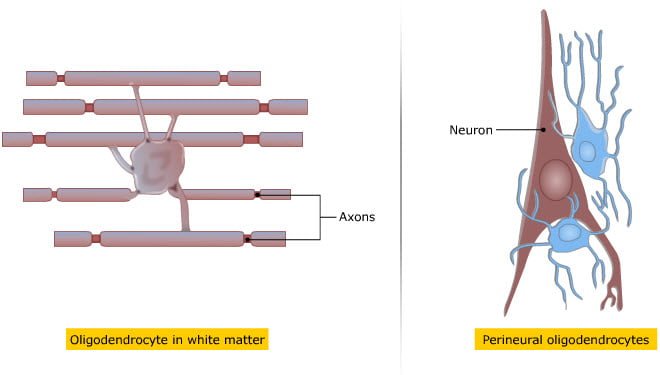Supporting cells of nervous system
Supportive cells of CNS are known as Glial cells or Neuroglia. Neuroglia is a special type of interstitial tissue which provides nourishment to the neurons. Glial cells serve as a connective tissue of the CNS and provide support the neurons, both physiologically and metabolically. They constitute 90% of cellular population, and they do not branch as neurons. They don’t participate in the initiation and conduction of nerve impulses. These cells homeostatically maintain composition of specialized environment surrounding the neuron.

Supporting cells of nervous system are classified according to shape, size and number of processes into three main types.
- Astrocytes ( star shaped, ectodermal origin)
- Protoplasmic astrocyte- grey matter of brain and spinal cord. They have branching of protoplasmic processes.
- Fibrous astrocyte- seen in white matter. They are long and have unbranched fibers.
- Oligodendrites( ectodermal origin)
- Microglia( smallest cells, mesodermal origin)
- Ependymal cells.
General functions of neuroglia
They provide support, insulation and phagocytosis. They support physically, metabolically and functionally. They provide biochemical and biophysical environment for proper functioning of neurons.
Astrocytes

- Astrocytes are most abundant in number and they are star shaped. They posses number of critical functions-
- During fetal development, they guide neurons for development.
- These cells are responsible for establishment for blood brain barrier.
- They act as a glue to hold the neurons together and confine their spatial relationship.
- They regulate the neurotransmitter activity by degrading and reabsorbing the neurotransmitter.
- They absorb excess potassium ion by activating sodium–potassium pump and maintains ionic environment suitable for neural excitability.
- They enhance synapse formation and potentiate synaptic transmission.
- Astrocytes communicate via gap junctions between themselves and neurons.
- Gap junctions are small tunnel like connecting units helping in signal communication.
- Astrocytes have receptors for neurotransmitter and they release stored calcium ion prior to the release of neurotransmitter by the presynaptic neuron.
- The release of calcium strengths the synaptic activity by accelerating the release of neurotransmitter.
- They secrete neurotrophic factors that protect neurons against excitotoxicity and oxidative insult.
Oligodendrocytes

Oligodendrocytes form the insulation by providing myelin sheath around the axons in the CNS.
Microglia
Microglia are the immune defense cells of the CNS. They derived from the parent tissues of monocytes and they migrate to CNS during development. They are active when there is an infection in the CNS otherwise the resting microglia releases nerve growth factor that help neuron and other growth cells to survive.
Microglia have primary responsibility of phagocytosis in the CNS. These cells have long branches radiating outward during phagocytosis. They are getting activated. They retract the branches with their high motility and move towards the infective area to remove the invaders. Activated microglia releases degrading chemicals to neutralize the tissue debris.
Ependymal cells
Ependymal cells line the internal cavities of vertebral CNS. They are of important as they contribute to the formation of CSF. Among the glial cells, they are ciliated and by the action of cilia the flow of CSF throughout the ventricles is regulated. An important characteristic of ependymal cells is that act as the stem cell which has the potential of forming glial cells and new neurons.
Supporting cells of PNS
Schwann’s cell are helpful in the formation of myelin sheath and provide insulation.






